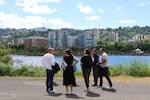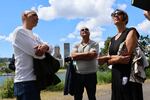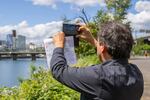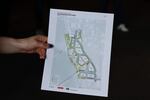This story originally appeared on Underscore Native News.

Project partners take a tour of the Portland waterfront on June 11, 2024, while discussing what it will look like once the project is completed.
Jerrette Werk / Underscore Native News/Report for America
Imagine a future in which first foods and medicines line the shores of the Willamette River in the OMSI district, Indigenous stories and design on full display, as flags from hundreds of Native nations fly proud.
This is the vision for the Center for Tribal Nations (CTN) — a hub of commerce and trade for the urban Indigenous community and Native nations across the Pacific Northwest.
“Ultimately, you have to have at your core this deep sense of understanding of protection and advancement of tribal sovereignty — I think that has to be at the forefront when you’re dealing with tribes,” said James Alan Parker, citizen of the Chippewa Cree Tribal Nation and executive director of the Northwest Native Chamber, which is helping to led the project. “I think we also have to have a deep understanding and a grounding in the place that we’re at.”
The Center for Tribal Nations will stand strong on the shores of the Willamette River in the central eastside, just across from downtown Portland. The spot has served as a confluence site for Native nations used for commerce, trade and relationship-building since time immemorial.
“Ultimately, it’s that kind of restoration for the 21st century of what that looks like to us today,” Parker told Underscore Native News/ICT.
The CTN just announced the architect team that will lead the project. After a long and detailed selection process, three Indigenous architects came together to form The Collaborative. They will work with a Portland architecture firm to secure permits.

James Alan Parker, citizen of the Chippewa Cree Tribal Nation and executive director of the Northwest Native Chamber, (center) says the project is a model for other cities to follow. “This is a global example of how major cities, urban populations, can engage with tribal nations and Native people,” Parker said.
Jerrett Werk / Underscore Native News/Report for America
Those involved in the project imagine a building that highlights Native designs and is a gathering place and economic hub for the Indigenous community. The building may include gathering spaces, a conference center, spaces for learning and a food hall, among other aspects.
“I’m excited about the impact the project will have,” said Sam Olbekson, citizen of the White Earth Nation of Minnesota Ojibwe, design project lead for CTN. “So that we can have an economy that transcends the U.S. basis of commerce, that focuses on building Indigenous economies.”
Though the design itself is still over a year out and the building won’t be completed for much longer, this project is about envisioning a space for the future generations. It’s also a reclamation of space along the Willamette River, which has held significant ties for Native nations since time immemorial.
“We’re returning back to an Indigenous economy that isn’t new,” Olbekson said, pointing to trade and relationships between Indigenous people that have always been a part of everyday life. “So this, in some ways, is innovative. And in many other ways, it’s returning back to a strength of economic thinking that is part of inherent sovereignty.”
An Indigenous-led design team
In Oregon, there are no Native-led architecture firms. In fact, across the country there are only a handful. As such, the CTN team made it a priority to reach out to all of them individually with an invitation to apply to the project.
The three architects leading the way to creating a fully Indigenous-led building design are: Olbekson as project lead; Wanda Dalla Costa, member of the Saddle Lake Cree Nation in Canada as principal in charge of the project; and Tammy Eagle Bull, Oglala Lakota from the Pine Ridge Indian Reservation, as the project planner.
“Tammy reached out to me pretty much right away to say ‘Hey, let’s not do the colonists’ way of competing against each other,” Olbekson said. “Let’s look at our combined strengths and create something that’s more Indigenous.”
Thus, The Collaborative was born.

Sam Olbekson, citizen of the White Earth Nation of Minnesota Ojibwe, design project lead for Center for Tribal Nations, pauses to snap a photo of the Portland cityscape during a tour of the OMSI district.
Jerrette Werk / Underscore Native News/Report for America
The team, along with Holst Architecture, is tasked with creating a design that brings together Native voices and experiences from all across the country. This means listening to the urban Native community in Portland, Native nations from the area and then looking to Native nations across the region and eventually across the country. That is no small task, but the team is up to the challenge.
“I’m excited to meet the communities and hear what the urban Indian populations want to see and what the tribal nations want to see,” said Eagle Bull.
Community engagement with Native communities is a central part of the creation of the CTN and will continue to be throughout the design process.
For Dalla Costa and the design team, part of that process will be rooted in a process she created, called the Indigenous Place Keeping Framework.
“Indigenous innovation is at the heart of this,” Dalla Costa said.
Dalla Costa’s Indigenous Place Keeping Framework is broken into five phases. Phase one is called “Indigenize startup,” which is about grounding in the protocol of the place and learning who key voices are. Phase two is “place-based research,” which involves learning about the Native nations in the region and establishing cultural competence. Phase three, “engagement,” is currently in the works as the CTN team continues to meet with the advisory board and plans trips to go visit communities with the designers. Phase four will be creating the design. And in phase five, the team will share the story of the building with the wider community.

An illustration of site plans for the future of the OMSI district, which will include affordable housing, a waterfront education park, the Center for Tribal Nations and more. (Photo by Jarrette Werk Underscore Native Native News / Report for America)
Jerrette Werk / Underscore Native News/Report for America
“It’s about understanding the stories. Architecture can be such a beautiful conveyor of cultural identity,” Olbekson said. “We live in an era now where we have the opportunity to express ourselves in a very contemporary and powerful urban Indigenous way.”
Envisioning the Center for Tribal Nations
On June 11, over two dozen Native community members and leaders from around the region gathered in a conference room in OMSI to meet the CTN design team. The Center for Tribal Nations Advisory Committee (CTNAC) and others involved with the project went around the room to introduce themselves — over half a dozen languages were spoken with people representing over 15 Native nations.
“There is a big task for designers to incorporate a lot of cultural and design information,” Renea Perry, Tlingit and Inupiat, the cultural and community engagement liaison for the CTN, told Underscore Native News/ICT. “We have high desert, we have the mountains, we have the forest, we have the coast. So bringing those environmental pieces together, but also the different kinds of cultural experiences and expressions to be integrated into the CTN.”
The dream for a hub for the urban Native community in the Portland metro area is not new. In fact, Native community members and organizations have been requesting that the City of Portland create a gathering space for urban Natives for decades, according to Parker and Perry.

A poster of Acosia Red Elk, world champion powwow dancer, that reads “Be a good ancestor,” was taped to the window of OMSI. Sam Olbekson, citizen of the White Earth Nation of Minnesota Ojibwe, design project lead for CTN, said being a good ancestor is at the core of this project, which will impact generations to come. “Because tribes, we’re not going away, this isn’t going away. This is a place that is going to be good for our citizens,” Olbekson said. (Photo by Jarrette Werk Underscore Native News / Report for America)
Jerrette Werk / Underscore News/Report for America
That is what the Center for Tribal Nations stems from — meeting the needs of a community and deciding that the design and vision must be led from the Native community throughout the entire process.
In the spring of 2020, OMSI submitted a grant application to Metro regional government that included funding for the CTN. A year later, the advisory committee formed and a group of Native community members and leaders have engaged in monthly listening sessions for the last two years.
As the design team dives into the process, continuing the engagement phase of the Indigenous Place Keeping Framework will be crucial. This means not only engaging with those on the advisory committee, but also planning trips to visit the Native nations surrounding the Portland metro area, starting with the Confederated Tribes of the Warm Springs, the Confederated Tribes of the Umatilla Indian Reservation and the Cowlitz Indian Tribe.
In a few decades, the OMSI District, along the east waterfront of downtown Portland, will be utterly transformed. Currently littered with gravel-strewn parking lots and gated plots of land, the future includes affordable housing, a waterfront education park weaving alongside the Willamette River and the Center for Tribal Nations.

Renea Perry, Tlingit and Inupiat, the cultural and community engagement liaison for the Center for Tribal Nations, talks about the project and its significance to the Portland Native community before breaking into smaller groups for a tour of the OMSI district.
Jerrett Werk / Underscore Native News/Report for America
“Every community, every site, has a story,” said Olbekson. “It’s about understanding the stories we want to tell through design. And architecture can be such a conveyor of culture.”
Together, Native community leaders hope that this project helps to create a permanent home and a hub of commerce and trade for the Indigenous community in Portland. And it will tell a story of reclamation along the shores of the Willamette River.
Underscore Native News is a nonprofit investigative newsroom committed to Indigenous-centered reporting in the Pacific Northwest. We are supported by foundations and donor contributions. Follow Underscore on Facebook, X, Instagram and TikTok.